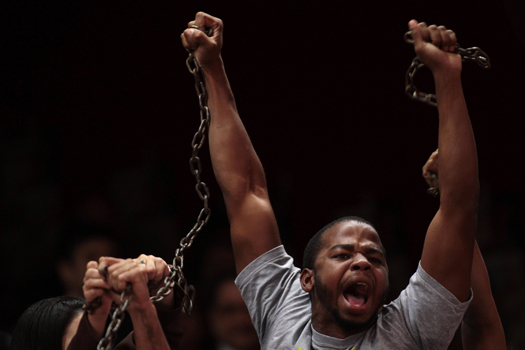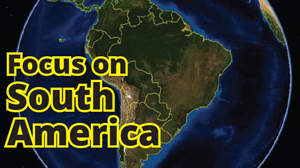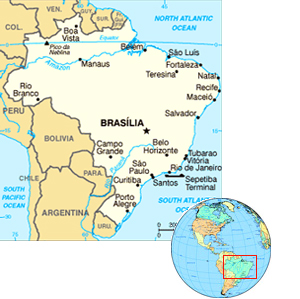Slave labor and the Brazilian government
By Mario Osava | Last updated: Nov 7, 2017 - 2:39:24 PMWhat's your opinion on this article?

A man holding chains protests slave labor outside the Chamber of Deputies in Brasilia, Brazil, May 8, 2012. Brazil's lower house was expected to vote on a constitutional amendment that would punish landholders found to be using slave labor. The proposed bill would allow the government to confi scate all property of those found to be using slave labor, among other penalties. Photo: AP/Wide World photos
|
RIO DE JANEIRO (IPS)— The wave of conservativism is testing its limits in Brazil, as reflected by a Labor Ministry decree that seeks to block the fight against slavery-like working conditions, which has been provisionally revoked by the justice system.
The powerful “ruralist” parliamentary bloc that represents agribusiness has been chalking up victories, such as keeping Michel Temer in the presidency, despite the disapproval of more than three-quarters of those interviewed in the latest polls, who see him as corrupt and are calling for his resignation.

|
According to political commentators, the weakening of the fight against slave labor, by means of the Oct. 13 ministerial resolution, was aimed at ensuring the ruralist bloc’s support for the government in the lower house of Congress which, on Oct. 25, blocked by a vote of 251 to 233, the judicial process against Mr. Temer on charges of obstruction of justice and criminal organization.
The measure could be a fatal blow to the actions of the Mobile Inspection Group which has already freed more than 50,000 modern-day slave laborer’s, warned Xavier Plassat, a Dominican friar who coordinates the campaign against slave labor in the Catholic Pastoral Land Commission (CPT).
The operations of the group, created in 1995 with Labor Ministry inspectors, federal police officers and prosecutors from the Labor Public Prosecutor (MPT), have already decreased sharply in recent years due to a shortage of budget and staff.
“It used to have ten teams, today there are only eight,” Mr. Plassat lamented in a telephone interview with IPS.
The ministerial decree modifies the concept of “work in slavery-like conditions,” limiting it to cases in which the worker is subjected to coercion and prevented from leaving the premises by armed guard and retention of documents, because supposedly the worker has “debts contracted with the employer.”
Other situations are now excluded from the concept and defined separately as “forced labor,” “exhausting workday” and “degrading conditions,” when imposed without the worker’s consent, made “contrary to law” and violating the rights and dignity of the person.

|
“The decree deconstructs the concept of slave labor, since between 70 and 80 percent of the cases recorded in the last 15 years were of degrading work, and the rest are a mixture of degradation, debt, physical control and confiscation of documents,” observed the friar who has won several awards in his fight for the eradication of modern-day slavery.
“Excluding ‘exhausting workday’ and ‘degrading work’ means ignoring three-quarters of the problem; there will be no punishment,” he argued.
The situations considered now by the Labor Ministry as modern-day slave labor were more frequently seen in activities such as deforestation, preparation of land for cattle and crops, production of charcoal and sugar-cane cutting, Mr. Plassat said.
But almost all of these activities have been mechanized, the deforestation of the Amazon has been reduced, and the use of charcoal in the production of pig iron has dropped sharply, due to a fall in international demand.
These were also some of the reasons for the decreasing number of workers freed in recent years.
From 2003—when the National Plan for the Eradication of Slave Labor was inaugurated—to April 2017, 34,940 workers were rescued, reaching a peak of 5,610 in 2007, followed by a sustained decrease down to 742 in 2016, according to CPT data on workers who received unemployment insurance after being released from slavery.
Discovering workers enslaved in the most brutal conditions has become more difficult, because these situations have moved deeper into the Amazon, along with “the deforestation that is now selective, in smaller areas, invisible to satellites, clandestine,” said the French-born friar, who has lived in Brazil since 1989.
Complaints from tax inspectors in the Labor Ministry and from public prosecutors, judges and human rights organizations, in addition to criticism from the International Labor Organization (ILO), forced the government to agree to review the measure.
But the temporary suspension of the ministerial decree, decided by Supreme Court Justice Rosa Weber, in response to a lawsuit brought by the Sustainability Network party, placed the final decision in the hands of the Supreme Court, which will deliberate on the validity of the decree.
The Brazilian government’s decision to change the definition of slave labor “interrupts a successful trajectory that turned Brazil into a role model and a global leader in the fight against slave labor,” and may undermine and restrain law enforcement efforts in labor, leaving “a portion of the Brazilian population even more fragile, unprotected, and vulnerable,” the ILO warned in a public statement.
The United Nations agency regretted that Brazil may move away from a definition of modern slave labor aligned with ILO conventions and the fulfillment of the Sustainable Development Goals by 2030.
In addition to narrowing the definition, the ministerial decree stipulates that the Ministry of Labor must approve the inclusion of employers found by inspectors to break the law on slave labor on a black list.
The so-called “dirty list” would thus enter into the political sphere, stripping the labor inspectors of their traditional autonomy established 126 years ago, protested the National Union of Auditors-Labor Prosecutors (SINAIT).
The measure would further hinder actions already “reduced due to a lack of resources, and to red tape,” according to Ivanete da Silva Sousa, administrative secretary of the Açailandia Center for the Defense of Life and Human Rights (CDVDH), a non-governmental organization that is active in Brazil’s Amazon region.
“The operations of the Mobile Inspection Group dropped from eight per year to four in 2016 and only one this year in Açailandia and nearby municipalities in which we operate,” she told IPS from that city.
The Center continues to receive reports of forced labor, but the Mobile Group only intervenes “in exceptional cases, when there are more than 20 people enslaved,” said da Silva, an activist with the group since it was founded in 1996.
“Our focus is slave labor, but we address other violations of labor rights, we provide job training and we defend urban and rural workers,” she said.
Açailandia stands out in this field because it was a recruiting city for hard labor in the Amazon in the past decades, being located in the state of Maranhão, a major provider of farmhands, and on the border with Pará, the state with the largest number of slave-like workers.
The reduction of inspections by the Mobile Group is also explained by the decrease in complaints of places where slavery is practiced, which exceeded 100 per year at the height of Amazonian deforestation between 2005 and 2007, and fell to 16 in 2016, Plassat said.
“But the commitment to the cause remains the same among the members of the group, be they labor inspectors, public prosecutors or federal police,” he said.
The inspections were also scattered around the country. Slaves are discovered even in large cities, especially in the construction and textile industries. The state of São Paulo, the most developed in Brazil, has accounted for two percent of rescued slave workers since 2003.
INSIDE STORIES AND REVIEWS
-
-
About Harriett ... and the Negro Hollywood Road Show
By Rabiah Muhammad, Guest Columnist » Full Story -
Skepticism greets Jay-Z, NFL talk of inspiring change
By Bryan 18X Crawford and Richard B. Muhammad The Final Call Newspaper @TheFinalCall » Full Story -
The painful problem of Black girls and suicide
By Charlene Muhammad -National Correspondent- » Full Story -
Exploitation of Innocence - Report: Perceptions, policies hurting Black girls
By Charlene Muhammad -National Correspondent- » Full Story -
Big Ballin: Big ideas fuel a father’s Big Baller Brand and brash business sense
By Bryan Crawford -Contributing Writer- » Full Story






 Click Here Stay Connected!
Click Here Stay Connected!








